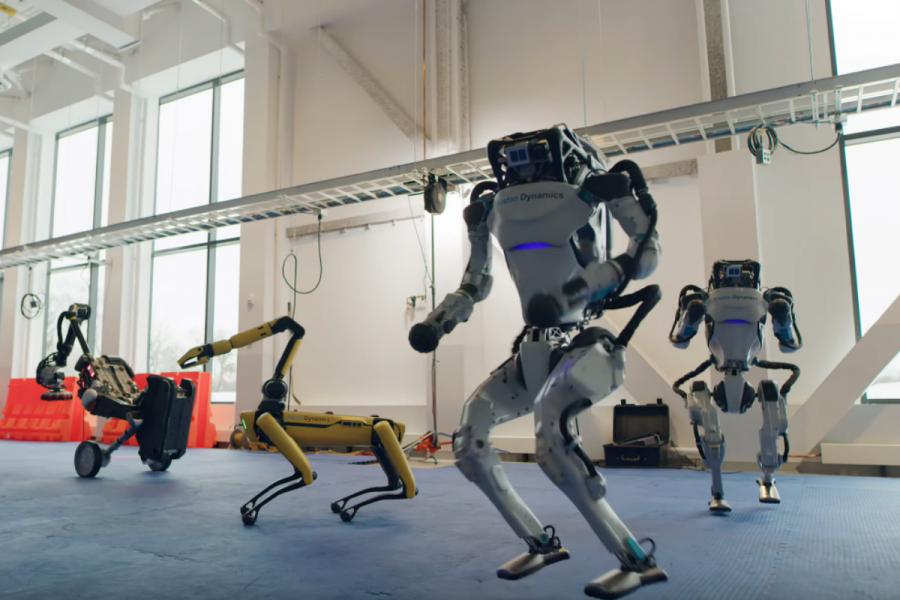Robot Reimagined
Kids all over the world grow up playing with robots. Inspired by Optimus Prime from Transformers and R2D2 from Star Wars, robots are an essential part of any childhood. Unfortunately, kids eventually outgrow toy robots, forgetting where they placed them just like Jessie from Toy Story. However, have you ever imagined human-sized robots dancing to “Do You Love Me” by The Contours? There are an infinite amount of possibilities if the interest in these technological machines continue past childhood. What if these very toys that could previously fit in children’s hands could now walk, dance, talk, sing, jump, flip, and crawl? A world of those possibilities is seemingly closer than we thought before.
What is Boston Dynamics?
Boston Dynamics is an American technology company that develops and engineers robots that mimic human mannerisms. They have the ability to walk through rough terrain and even use their hands to pick things up. Boston Dynamics, owned by Google’s parent company Alphabet in the past, is now owned by the Japanese conglomerate SoftBank. Boston Dynamics was founded in 1992 as a spin-off company from MIT, and much of its early finance came from military programs. Masayoshi Son, who loves robots, is SoftBank’s founder. Boston Dynamics’ founder and CEO is Marc Railbert. Railbert remarks on how far his company has come, “It’s really a milestone for us going from robots that work in the lab to these that are hardened for work out in the field.”
Who are these robots?
Boston Dynamics has made countless robots over the years, some of which are named BigDog, SandFlea, and WildCat. However, the most advanced and most famous of these robots are Spot, Atlas, and Handle.
Atlas is the most well known and dynamic humanoid robot of the three. At 4’11” (150 cm) and 176 pounds (80 kg), and with a speed of 3.36 mph (5.4 kmph), Atlas’s actuators are driven by a compact 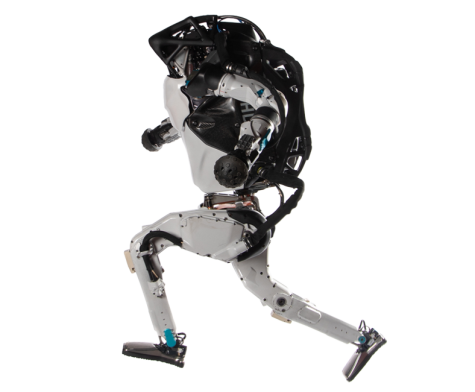 but powerful hydraulic system, which gives it the strength needed to perform acrobatics. Actuators are devices that serve as muscles by converting electronic or physical signals into movement. Atlas is known for having “robot blood” in this hydraulic system. When a line is damaged, Atlas “bleeds”, as the fluid happens to be red. It uses lidar and stereo vision to sense its surroundings. Atlas is composed of parts made from 3D printers to give it its strength-to-width ratio that allows it to perform somersaults and flips. This current version of Atlas is an upgrade from the original model, which was built for the DARPA Robotics Challenge back in 2015. The current version is much lighter and has many new improvements such as the ability to stand back up after a fall. With these attributes, Atlas is able to use its whole body when jumping or running, just as a human would.
but powerful hydraulic system, which gives it the strength needed to perform acrobatics. Actuators are devices that serve as muscles by converting electronic or physical signals into movement. Atlas is known for having “robot blood” in this hydraulic system. When a line is damaged, Atlas “bleeds”, as the fluid happens to be red. It uses lidar and stereo vision to sense its surroundings. Atlas is composed of parts made from 3D printers to give it its strength-to-width ratio that allows it to perform somersaults and flips. This current version of Atlas is an upgrade from the original model, which was built for the DARPA Robotics Challenge back in 2015. The current version is much lighter and has many new improvements such as the ability to stand back up after a fall. With these attributes, Atlas is able to use its whole body when jumping or running, just as a human would.
Standing at a height of 2’9” (83.82 cm) and weighing almost 53 pounds (24 kg), Spot is an agile mobile robot that can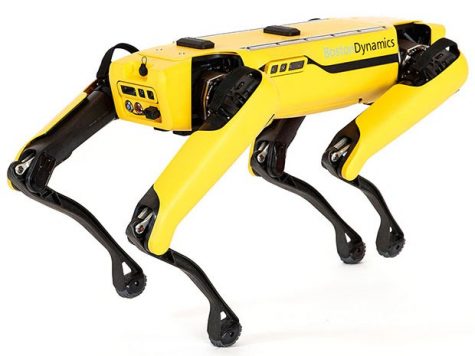 move at a speed of 3.58 mi/hr. Spot gives people the ability to automate routine inspection tasks. It also helps capture data more productively, putting stereo cameras and position/force sensors to use to sense its surroundings.
move at a speed of 3.58 mi/hr. Spot gives people the ability to automate routine inspection tasks. It also helps capture data more productively, putting stereo cameras and position/force sensors to use to sense its surroundings.
Handle is a mobile robot used for moving items around in warehouses. It can operate in multiple work cells and move through facilities a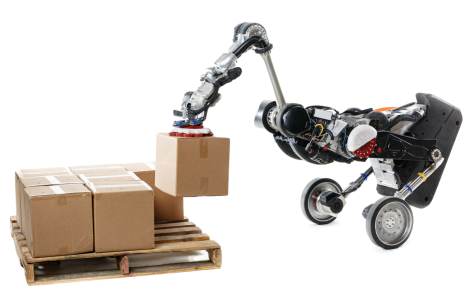 long with the flow of goods. Handle is designed to reach boxes both high and low and can fold into a compact form easy for moving around. Its small footprint, long reach, and deep learning vision software help Handle identify and locate boxes, unload trucks, build pallets, and move up to 360 boxes per hour.
long with the flow of goods. Handle is designed to reach boxes both high and low and can fold into a compact form easy for moving around. Its small footprint, long reach, and deep learning vision software help Handle identify and locate boxes, unload trucks, build pallets, and move up to 360 boxes per hour.
Why did these robots gain fame?
On December 29, 2020, a video was uploaded onto the Boston Dynamics YouTube channel. This video, titled “Do You Love Me?” featured the song of the same name. It was uploaded as the Boston Dynamics company was celebrating the end of 2020, a year of a global pandemic and political wars. During its first week on the internet, the video amassed 23 million views. Now, it is currently sitting at an impressive 27 million. The VP of Engineering, Aaron Saunders mentions the success of the video with, “We have different expectations for the videos that we make; this one was definitely anchored in fun for us. The response on YouTube was record-setting for us: We received hundreds of emails and calls with people expressing their enthusiasm, and also sharing their ideas for what we should do next, what about this song, what about this dance move, so that was really fun.”
The human-like movements of the robot Atlas incited varied reactions from the public. Some were astonished by how real it looked. They were fooled and thought that a person was inside of Atlas, controlling its movements. Others thought that it was fake. They reasoned that it must have been made using computer graphics, or CGI. Countering these rumors, Marc Railbert, the founder of Boston Dynamics, claims that it is completely real, and the “result of hard work”.
How did the dancing translate into the robots?
Art and science came together in this video as Boston Dynamics collaborated with professional choreographer Monica Thomas, who is responsible for the choreographic collaboration Mad King Thomas. The Atlas robot uses a wide range of sensors to perform the dance moves, involving its 28 actuators. Equipped with three powerful computers as well, with one processing perception signal and two controlling movements, the translation of human dance movements made its way into the robot, making it possible for this innovation.
Robots at NAI
Interested in robotics? Boston Dynamics’s new innovations are just some examples of the currently growing field of robotics. This field combines computer science, engineering, and various design aspects to create machines that help and assist humans. NAI has its very own robot engineering classes as well as a robotics club. Robotics will be huge in the future, and learning the basics from these classes in highschool can allow you to be a part of this future. Can you imagine yourself making one of these robots that could wow the world in a viral YouTube video?
Boston Dynamics has spent years perfecting their creations over and over again. Pushing the edge of technology, they have managed to build robots that can mimic human movements much more clearly and easily than anything in the past. They have crossed the boundary of simply making robots for functionality purposes to adding an artistic component, attracting millions of views from intrigued onlookers. Can you imagine a time where future dance classes are taught by robots?
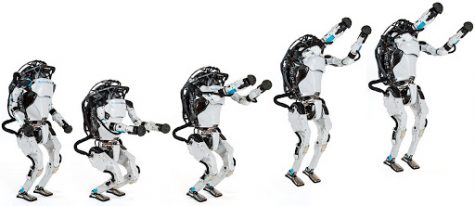
“That’s one small step for robots, one giant leap for technology.”


